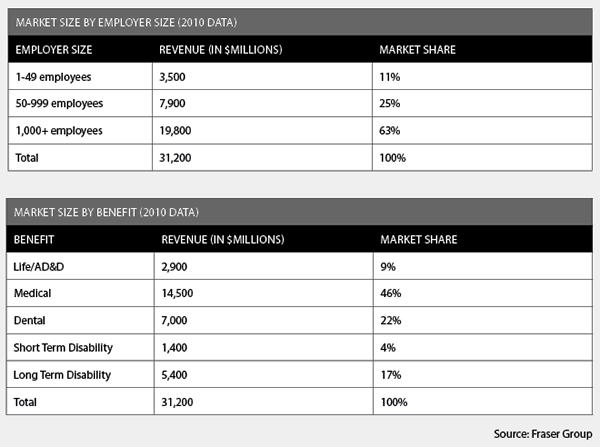Group insurance revenue grew modestly in 2010 despite a highly dynamic market. Don’t blame the economy. In recent years, the slowdown in drug price inflation has done much to ease the artificial growth of group premiums.
Overall, the group insurance market reported revenue of $31.2 billion in Canada in 2010, for growth of 3.8% since 2009. These figures appear in the latest report by Fraser Group, a market information and research firm working in the group pension and insurance markets.
This low rate of growth contrasts with the activity in the market. “There’s been a fairly good level of activity in the market in 2010 and 2011 is quite busy,” says Ken Fraser, president of Fraser Group. For example, many life groups changed suppliers since 2010, which generated a flurry of activity in this sector, he adds.
The growth rate in 2010 was hampered mainly by the slowdown in the rise of drug costs, Mr. Fraser explains. The Ontario and Quebec governments are encouraging the use of generic drugs, which has created pressure to reduce drugs prices in both public and private plans.
Ontario accounted for more than half of group insurance revenue in Canada in 2010 (53%) while Quebec held 17%. The Prairies represented 15% and British Columbia 10%. The Atlantic provinces held 5% of the group insurance market in 2010.
Groups of 1000 employees or more make up 63% of the group insurance market in Canada in 2010.
Continuing momentum
2011 was a big year for several insurers, as the momentum of 2010 continued. At Sun Life Financial, Josée Dixon regional vice-president, business development, eastern region, group benefits and group retirement services, even qualified it as a “party.” She pointed to marked revenue growth in dental and especially health care benefits. Both weigh heavily in Sun Life’s group insurance business portfolio because the insurer is well positioned in the large company niche, Ms. Dixon explains.
Sun Life sales have been vigorous in 2011 and are likely to maintain this momentum into 2012. “We gained many new groups in 2011 and the same thing will happen in 2012,” Ms. Dixon continues. A very large group (national account because it operates across Canada) that had left us in early 2011 is coming back in 2012. It’s the first time I’ve seen this in 27 years,” she says.
Desjardins Financial Security (DFS) describes 2011 as one of its best three years in the last decade. All the same, DFS forfeited the CGI Group clientele to Industrial Alliance this year. “We lost almost $40 million in premiums, but our excellent sales made up for it,” says André Simard, vice-president, sales, group and business insurance at DFS.
The insurer sold $175 million in new group insurance premiums in 2011, which represents growth of 40% compared with 2010, when sales stood at $125 million. DFS is reaping the fruits of the sustained expansion of its group insurance operations outside Quebec.

“We should reach $2 billion in premiums in force in Canada by the end of 2011, more than half of which come from outside Quebec. This will be the first time in our history,” Mr. Simard points out.
Market breakthrough
A player renowned for its presence in the public sector, SSQ Financial Group has made a major thrust into the private sector says Carl Laflamme, vice-president sales and marketing at SSQ. This market breakthrough will continue next year. “We recently sold a contract to the Jean Coutu Group and its 9000 employees. This sale will be included in our 2012 figures,” Mr. Laflamme adds.
Smaller players also shone. Industrial Alliance landed two big fish in 2011: CGI Group and many additions to the existing contract with National Bank of Canada. After launching a call for tenders in 2010, NBC grafted short-term and long-term disability benefits to its program, along with a plan for its subsidiary National Bank Financial, drawing 2000 more employees. CGI brought 12,000 employees into the Industrial Alliance fold.
“It’ll be a record year: our sales will top $100 million,” says Jacques Parent, vice-president, sales and underwriting, group insurance at Industrial Alliance. The insurer’s in-force will approach $1 billion.
The group insurance market is very competitive, insurers say. Many groups “got back in the market” in 2011 to shop around for better prices from their insurer or the competition. “Despite all this, Sun Life had a 96.8% retention rate in 2010. That’s phenomenal,” Ms. Dixon says. Clients that loyal prove the positive impact of excellent communication with plan members, she says.
Yet the insurer experienced high turnover in the under-50 employee group niche. “These groups are price sensitive because of the current economic environment. They’re also being courted by all the insurers,” Ms. Dixon continues.
Mr. Laflamme of SSQ describes the competition as fierce across Canada. “Major opportunities just slipped by us outside Quebec, where sales fell short of expectations. But our name is getting out there more and more. We are taking on the large Canadian group insurers, something previously beyond our reach,” he says.
SSQ Life boasts a group business retention rate of above 95%.
Although pleased with DFS’ retention rate, Mr. Simard admits that the loss of CGI will affect the insurer. He thinks the current trend favors retention.

“Many groups that go on the market decide to remain with their insurer because it will do what it can to keep the client. Also, entrepreneurs that shop around must maintain a balance between the desire to reduce expenses because of economic uncertainty and to attract and retain good employees to face the competition. It’s the second goal that prevails because employee benefits are generally the last place that companies will cut, he explains.








